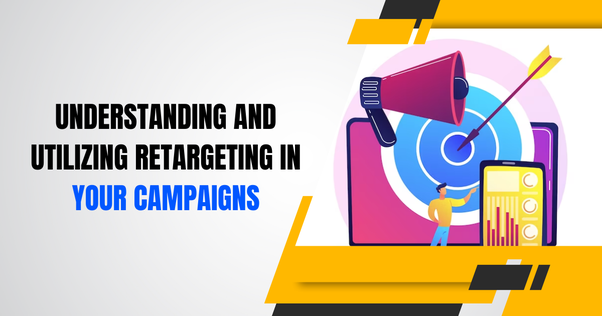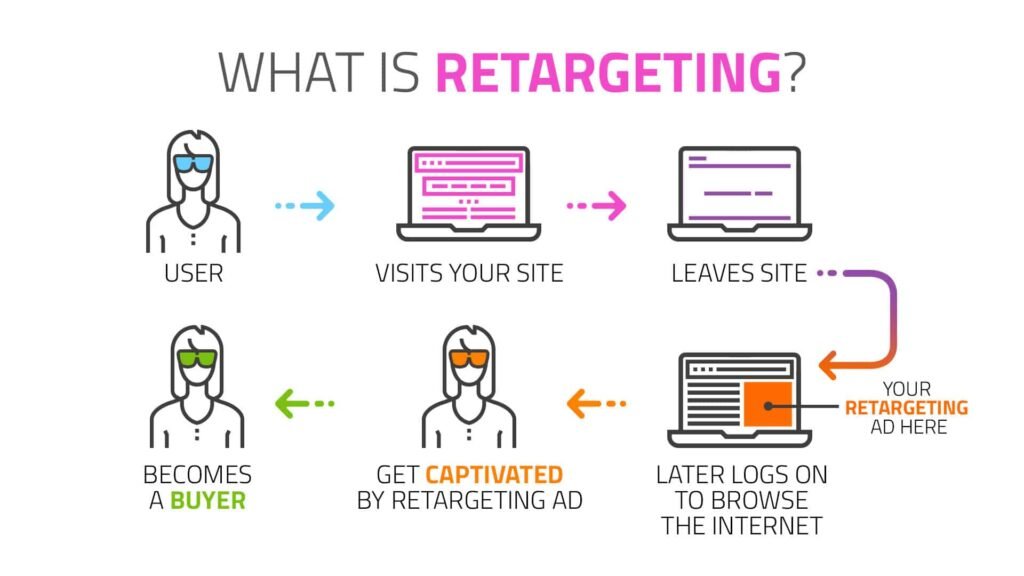Introduction
In the competitive world of digital marketing, capturing and maintaining customer attention is an ongoing challenge. Potential customers often visit websites, browse products or services, and leave without making a purchase or taking any desired action. According to research, over 90% of first-time visitors to a website leave without converting. This is where retargeting, a powerful marketing strategy, comes into play. By keeping your brand in front of potential customers and encouraging them to return and complete a desired action, retargeting can dramatically improve the effectiveness of your campaigns.
In this blog, we will explore what retargeting is, how it works, and how you can use it to boost your marketing efforts and drive conversions.

What is Retargeting?
Retargeting is a digital marketing strategy designed to re-engage users who have previously interacted with your brand but have not completed a specific action, such as making a purchase, signing up for a newsletter, or downloading a resource. It works by placing a tracking pixel or cookie on the user’s browser when they visit your website. This tracking mechanism allows you to display personalized ads to those users as they navigate other websites, social media platforms, or search engines.
The primary goal of retargeting is to keep your brand top of mind for potential customers and encourage them to return to your website to complete the desired action. By targeting users who have already shown interest in your products or services, retargeting ensures that your advertising efforts are focused on a warm audience, which is more likely to convert.

How Retargeting Works
It relies on cookies and pixels to track user behavior. Here’s a step-by-step breakdown of how it works:
Tracking User Behavior: When a visitor lands on your website, a small piece of code known as a tracking pixel is embedded in their browser. This pixel collects anonymous data about the user’s interactions with your site, such as the pages they visited, products they viewed, or actions they started but didn’t complete.
Building an Audience: Based on the data collected, you can segment your audience into groups based on their behavior. For example, you might create a segment for users who added items to their cart but didn’t complete the checkout process.
Displaying Retargeting Ads: Once you’ve built your audience segments, you can create personalized ads tailored to each group. These ads are displayed to users as they browse other websites, use social media platforms, or conduct searches online.
Encouraging Conversions: The retargeting ads serve as reminders of your brand and can include incentives such as discounts, free shipping, or limited-time offers to entice users to return and complete the desired action.
Types of Retargeting
- Site Retargeting: This involves targeting users who visited your website but didn’t take a specific action. Ads are displayed to these users as they browse other websites or platforms.
Search Retargeting: This targets users based on the search terms they entered on search engines. For example, if someone searches for “best running shoes,” they may see ads from your brand selling running shoes, even if they haven’t visited your site.
Social Media Retargeting: Platforms like Facebook, Instagram, and LinkedIn allow you to retarget users based on their interactions with your social media profiles or website. Social media retargeting is effective for engaging users in a highly visual and interactive environment.
Email Retargeting: If users open your emails but don’t click through to your website, you can retarget them with ads based on the content of the email. This approach helps reinforce your message and keeps users engaged.
Dynamic Retargeting: This advanced form of retargeting displays personalized ads featuring the specific products or services a user viewed on your website. For example, if a user browsed a pair of sneakers on your site, they might see ads showcasing that exact pair of sneakers, increasing the likelihood of a purchase.
Benefits of Retargeting
- Increased Conversions: By targeting users who have already expressed interest in your brand, retargeting focuses on warm leads that are more likely to convert. This targeted approach often leads to higher conversion rates compared to cold audience campaigns.
Enhanced Brand Recall: Retargeting keeps your brand in front of potential customers as they navigate the web. This repeated exposure strengthens brand recall and builds familiarity, making users more likely to choose your brand when they’re ready to purchase.
Cost-Effective Advertising: Since retargeting focuses on users who are already familiar with your brand, the cost-per-click (CPC) or cost-per-impression (CPM) is often lower compared to targeting cold audiences. Additionally, the higher conversion rates help maximize your return on investment (ROI).
Personalized Customer Experience: Retargeting allows you to deliver highly personalized ads tailored to individual user behavior. This personalization creates a more relevant and engaging experience for users, increasing the likelihood of conversion.
Recovery of Lost Leads: Many users abandon their shopping carts or leave your website without completing a desired action. Retargeting gives you a second chance to recover these lost leads by reminding them of your offerings and encouraging them to return.
Best Practices for Retargeting
To make the most of your retargeting campaigns, follow these best practices:
Segment Your Audience: Divide your audience into smaller, behavior-based segments to deliver tailored ads that resonate with each group. For example, target cart abandoners with discount offers or users who visited a specific product page with detailed product ads.
Set Frequency Caps: Avoid bombarding users with excessive ads by setting frequency caps. Overexposure can lead to ad fatigue and a negative perception of your brand.
Use Compelling Ad Creatives: Design eye-catching ads with clear calls to action (CTAs). Highlight the benefits of your products or services and include incentives like discounts or limited-time offers.
Leverage Dynamic Retargeting: For e-commerce businesses, dynamic retargeting is a powerful tool to showcase the exact products users viewed, increasing the chances of conversion.
Monitor and Optimize: Regularly analyze the performance of your retargeting campaigns and make data-driven adjustments to improve results. Test different ad creatives, CTAs, and audience segments to identify what works best.
Ensure Mobile Compatibility: With the increasing use of mobile devices, ensure that your retargeting ads are optimized for mobile users to reach a broader audience effectively.
Respect Privacy Regulations: Adhere to data privacy laws like GDPR and CCPA by obtaining user consent and providing transparent information about data collection practices.
Common Challenges in Retargeting and How to Overcome Them
While retargeting is a highly effective strategy, it does come with its challenges:
Ad Fatigue: Overexposing users to the same ads can lead to diminishing returns. Rotate your ad creatives regularly and limit the frequency of impressions.
Poor Segmentation: Failing to segment your audience can result in irrelevant ads, reducing campaign effectiveness. Invest time in creating detailed audience segments.
Privacy Concerns: Users are becoming increasingly cautious about data privacy. Be transparent about your tracking practices and provide options for users to manage their preferences.
Attribution Challenges: Accurately attributing conversions to retargeting efforts can be tricky. Use advanced analytics tools to track the performance of your campaigns and understand their impact on your overall marketing strategy.
Conclusion
Understanding and utilizing retargeting in your campaigns is essential for driving conversions and maximizing the impact of your marketing efforts. By re-engaging users who have already shown interest in your brand, retargeting allows you to focus your resources on warm leads, improve ROI, and create a more personalized customer experience. Implement best practices, monitor performance, and continuously optimize your campaigns to unlock the full potential of retargeting. When executed effectively, retargeting can be a game-changer for your business, helping you recover lost leads, boost conversions, and stay ahead in the competitive digital landscape.